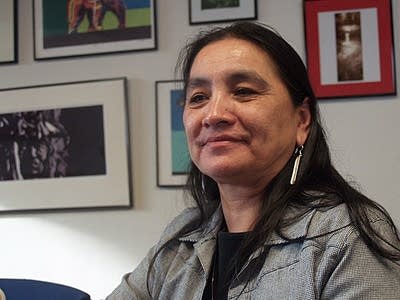Study finds untapped potential in Native American art

A new University of Minnesota study suggests that if helped, Native American artists could become a major economic asset to the state.
Demographer Ann Markusen and writer Marcie Rendon, an enrolled member at the White Earth Band, interviewed dozens of native artists around the state for the study. They talked to visual artists, writers, performers and a host of others. Markusen said they discovered many things.
"There are a lot of native artists doing extraordinary, high-quality work [and] that their work doesn't get the visibility that it deserves," Markusen said.
Markusen points to a number of reasons for this. Many are working on reservations, in areas with high levels of poverty.
Create a More Connected Minnesota
MPR News is your trusted resource for the news you need. With your support, MPR News brings accessible, courageous journalism and authentic conversation to everyone - free of paywalls and barriers. Your gift makes a difference.
"Their own communities can't really afford that much to patronize their work," Markusen said, "Although they do have casinos and other government buildings that could do a lot better job of hosting their performances and buying their visual art, and there are some wonderful cases of that."
This lack of patronage then creates another challenge.
"We discovered they have higher self-employment rates than other artists in general, which are already high," she said.

Working alone means these artists often have to do everything from booking shows, and doing publicity, to finding educational opportunities in their field. All this while actually doing their creative work to pay the bills. There are also culturally specific challenges for some artists working with subjects and materials of spiritual significance.
Markusen said however, with support, American Indian artists could become a major asset to the state.
"Minnesota could really be taking advantage of the distinctiveness of this native art work as part of its signature," she said. "It's something that could draw tourists, could help people here recycle their money within their own community. You can see the effect that native artwork has had in the southwest in this regard."
She said native artists can also provide an immensely valuable cultural bridge between the native and the other communities now in Minnesota.
"You know they are doing work that addresses their own community, but also other communities and they are helping cross this bridge, and helping us understand our history together, and how to heal from that and move forward," she said.
The report concludes with several recommendations, including encouraging decision makers at galleries, museums, and even hotels and casinos to being more open to buying native art.
Report co-author Marcie Rendon said just getting the casino gift shops on board could be huge.
"In reality,a lot of the gift shops are run by marketing programs or non-native people," Rendon said.
The report states education and mentoring programs aimed at native artists have been effective. Markusen suggests creating a native art market in Minnesota would also help. She said it could act as a central point for selling art work, and for encouraging critical discourse about the pieces
Juanita Espinosa is director of the Native Arts Circle, which supports native artists. The organization also runs the Two Rivers Gallery at the Minneapolis American Indian Center.
She said she welcomes the report, but knows through her own work, including a study done some years ago, that such research can produce more questions than answers.
One is the question of why create art? She said while it's good to make money, for many native artists it's more about preserving culture.
"I think those are the bigger issues that we struggle with in today's economy, is recognizing these paths are here for a reason," Espinosa said. "They are important paths. They are paths that need to be walked, and the stories told that go with that trail."
The University of Minnesota's Ann Markusen hopes the report will generate discussion. In fact, she wants to use it as the basis of at least one gathering in the next year.
"In which we will invite native artists to come together and help educate each other about what worked for them and didn't, and to have an art exhibit and some performance," Markusen said.
In the meantime, Markusen is focusing on sending the report out to artists, galleries, museums, elected officials, tribal governments, casinos, anyone who wants to take part in the debate.
